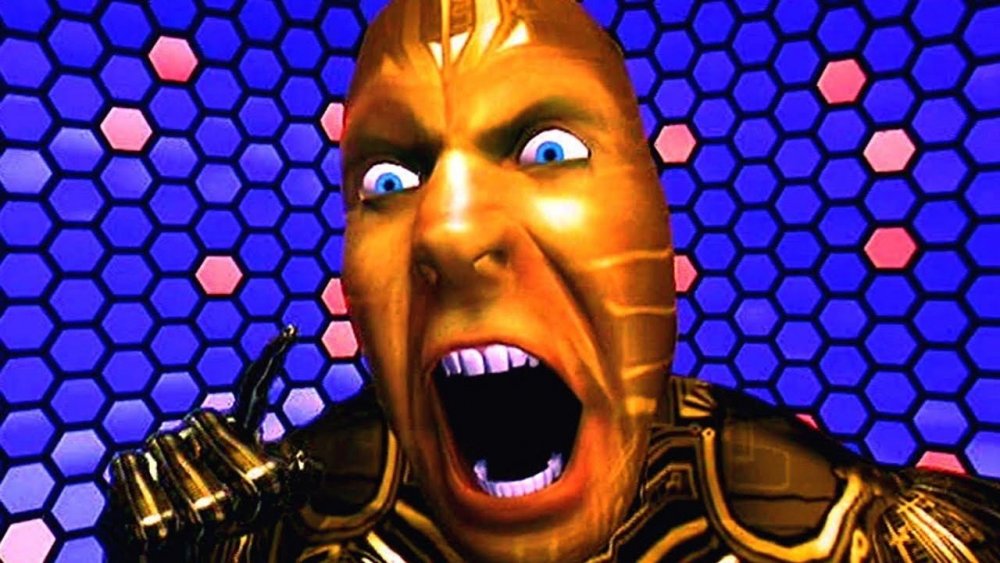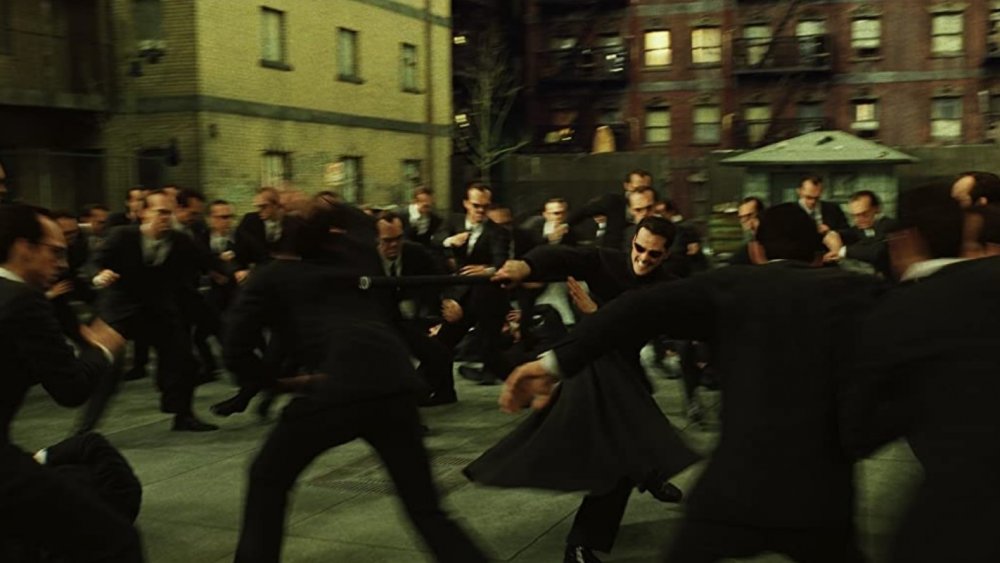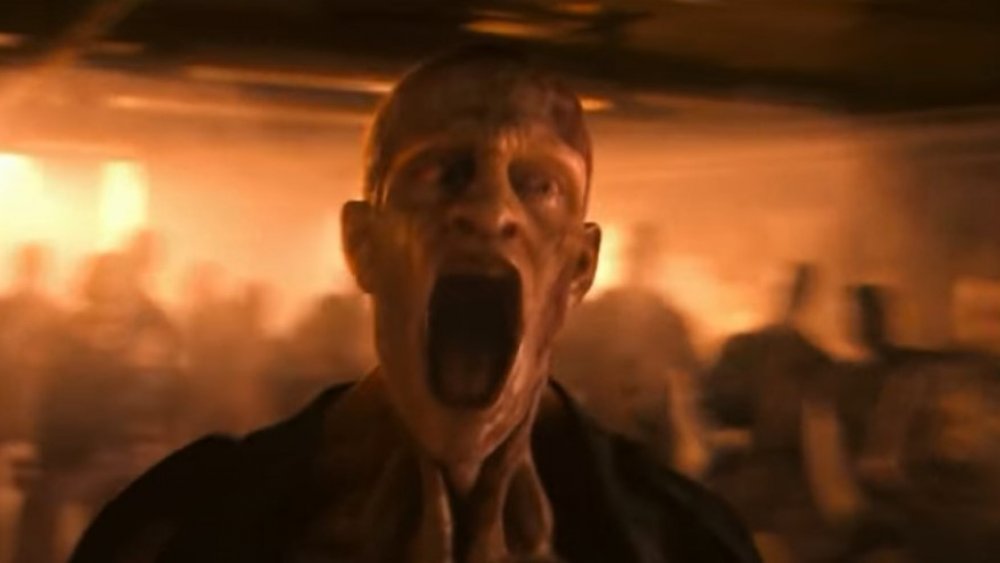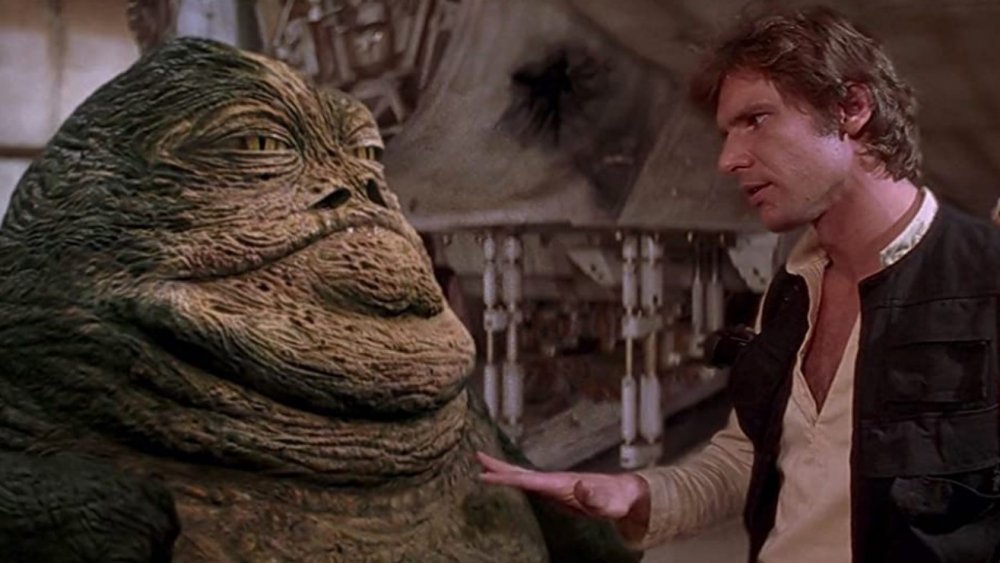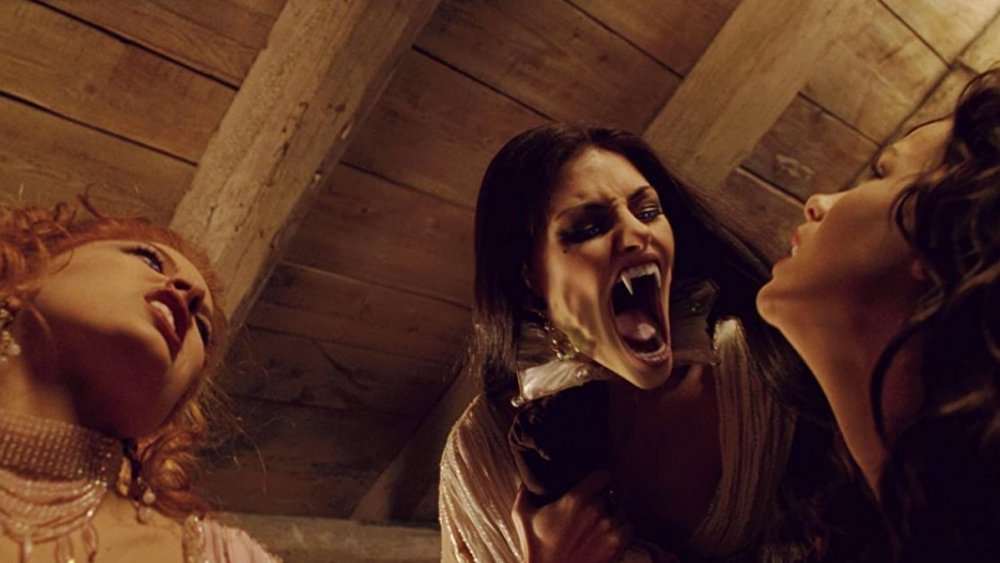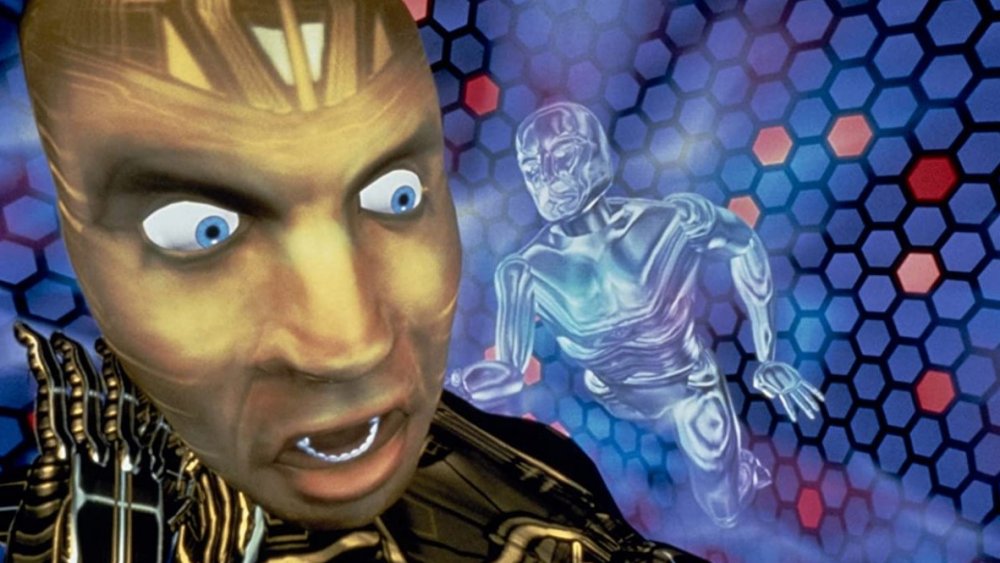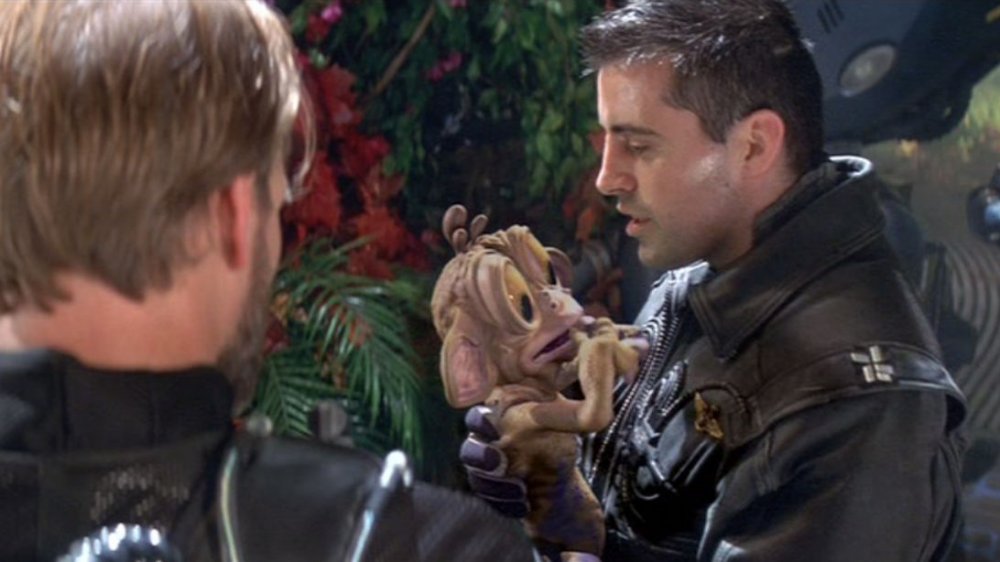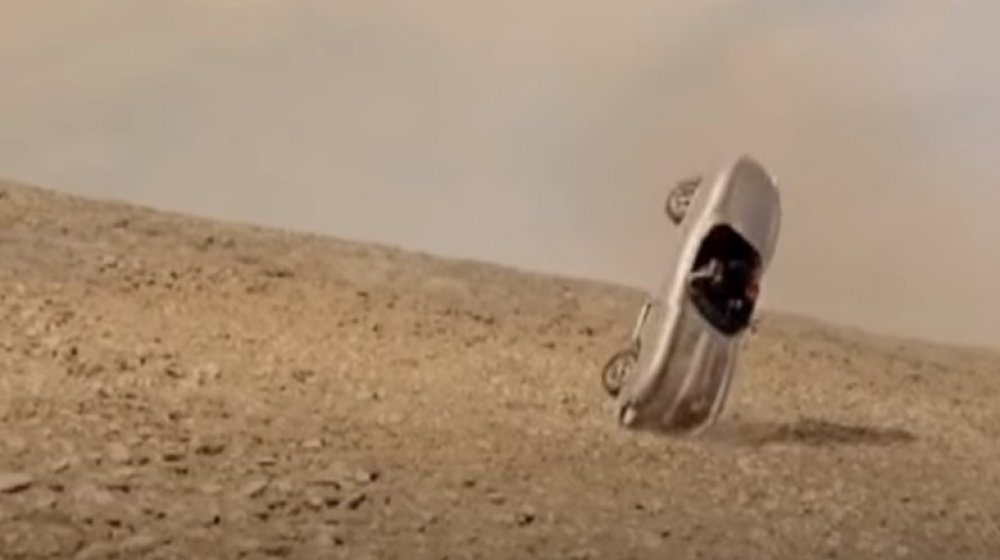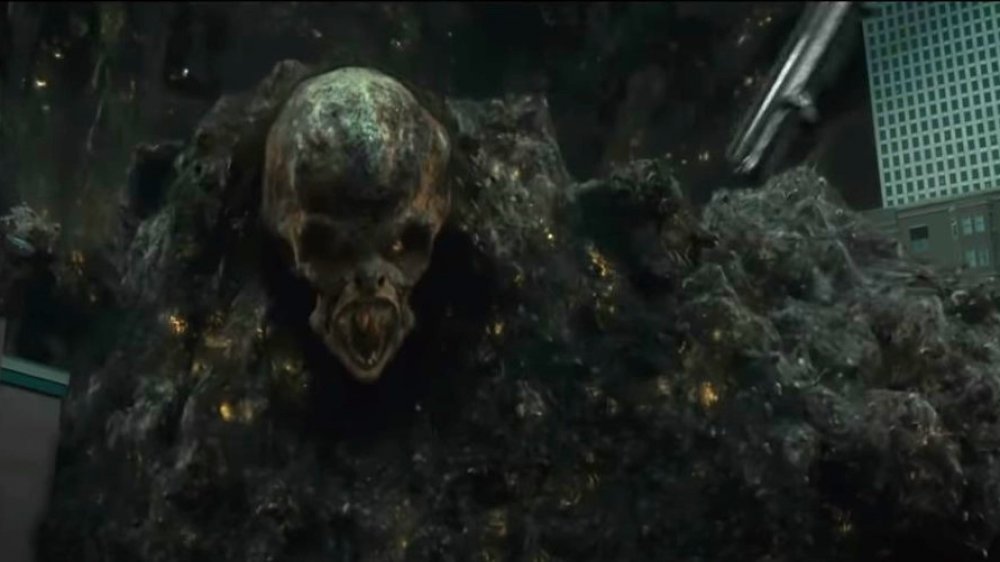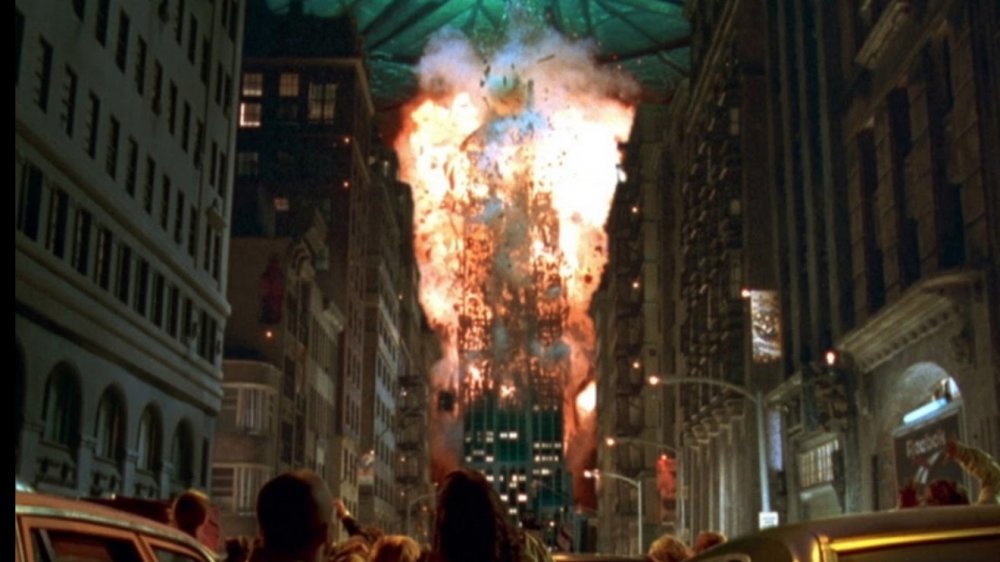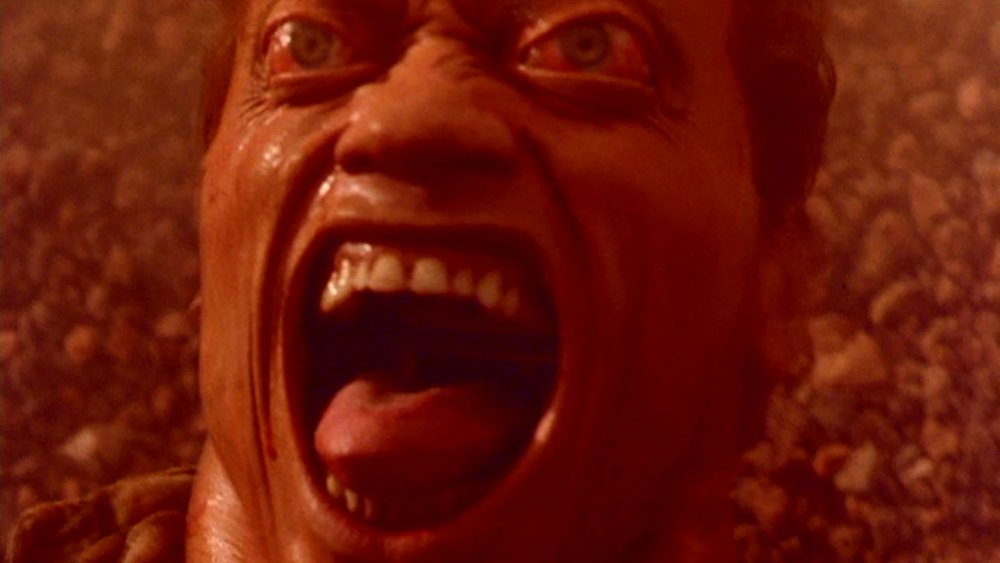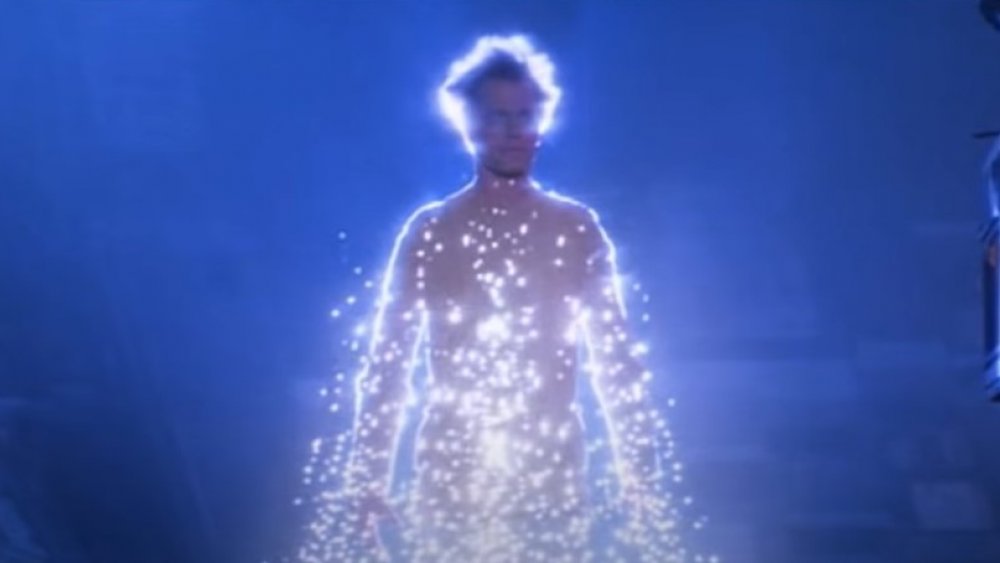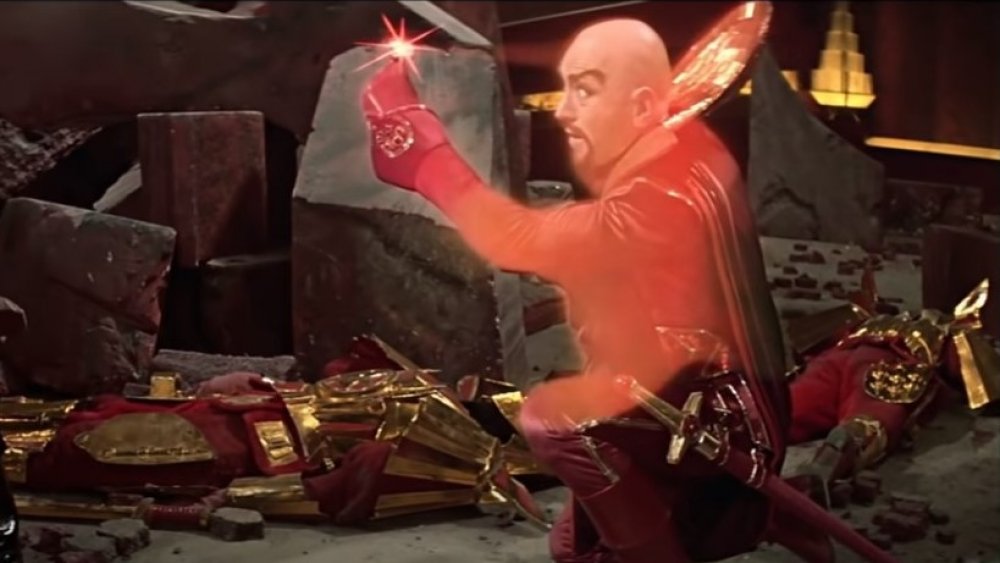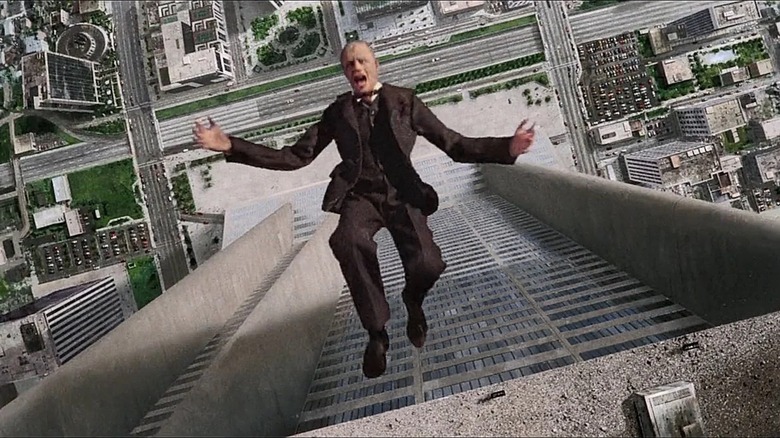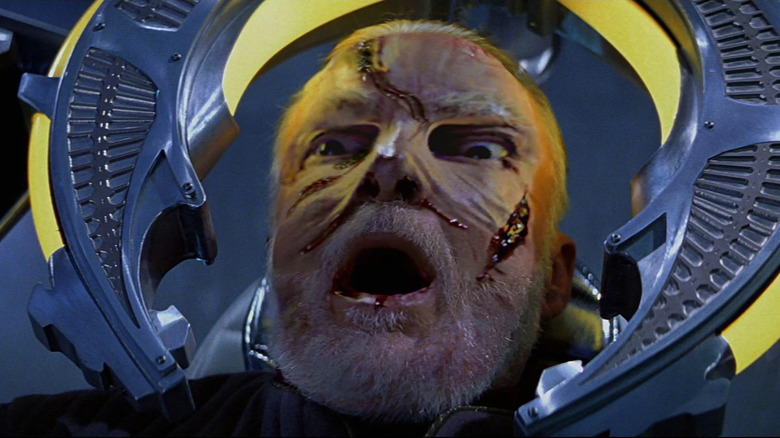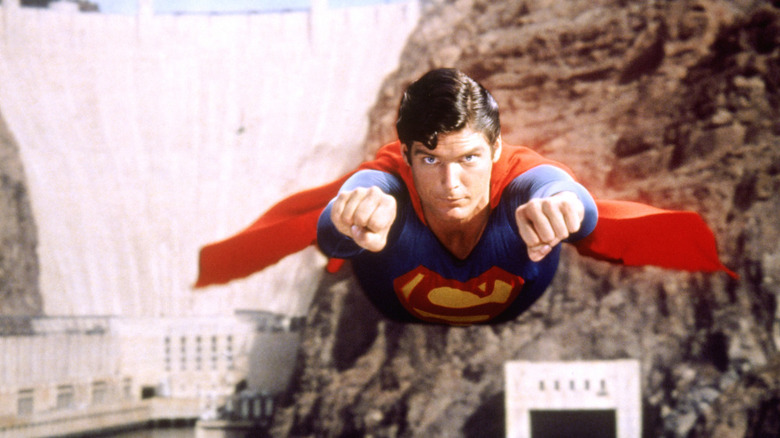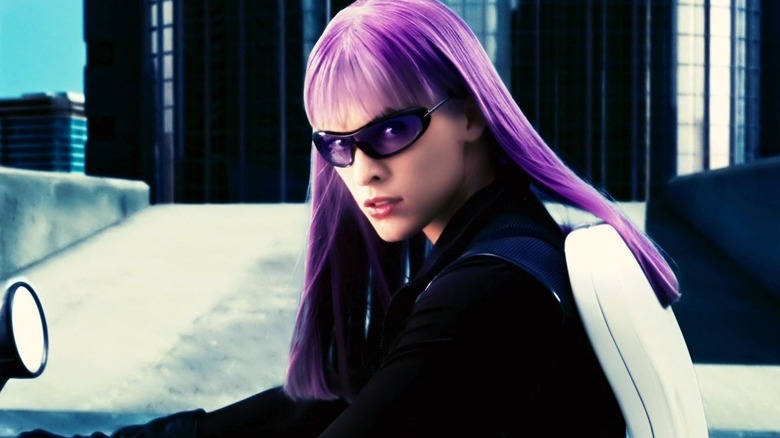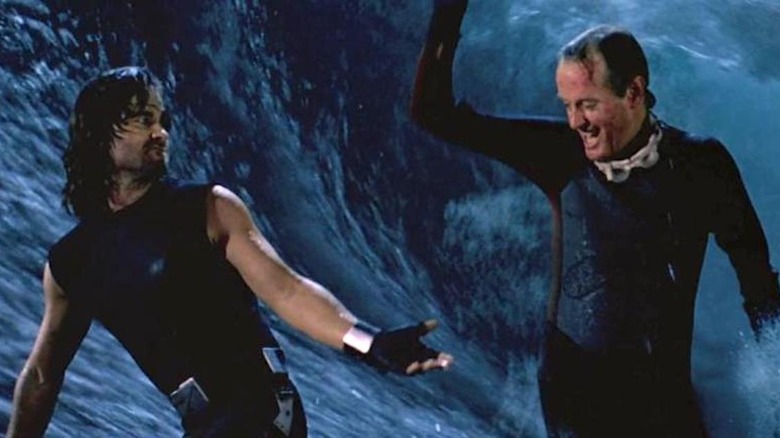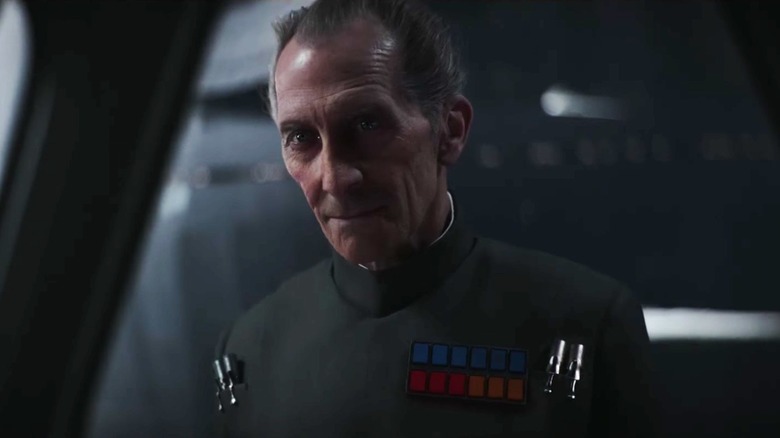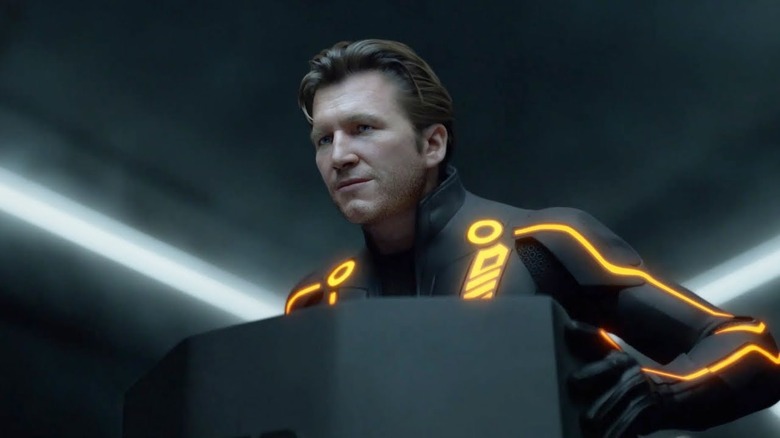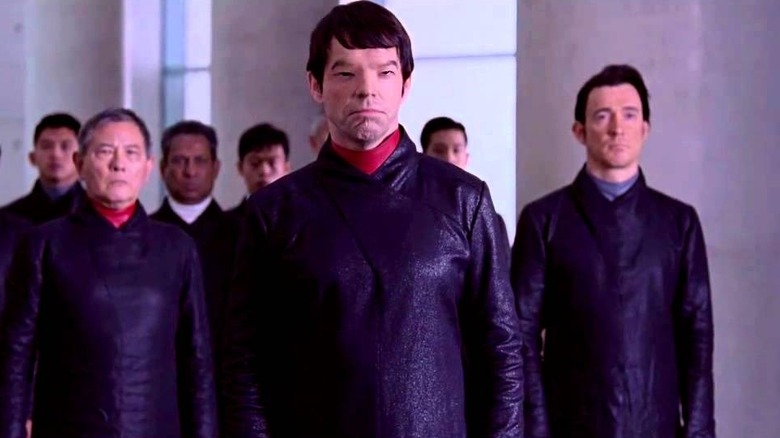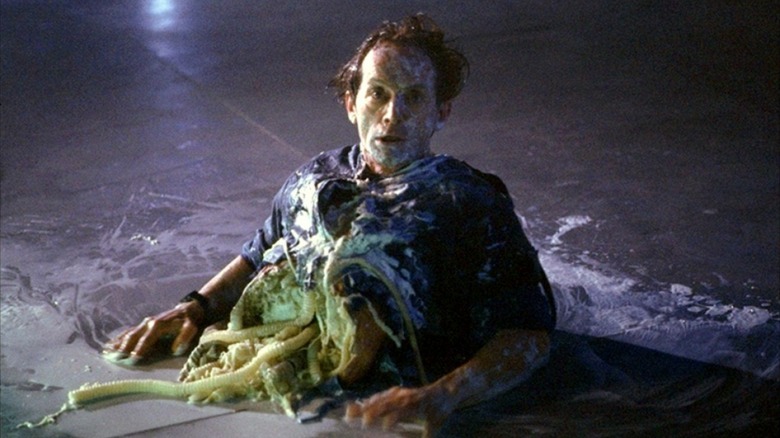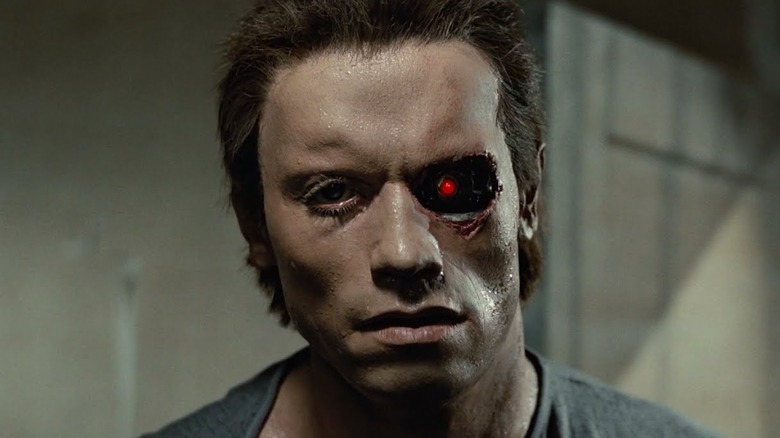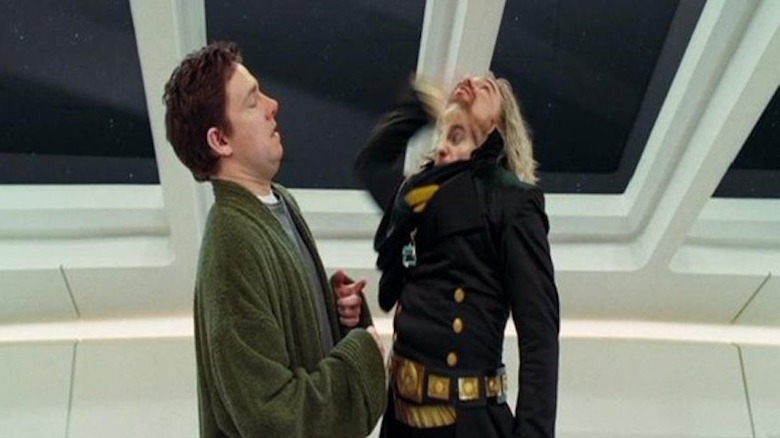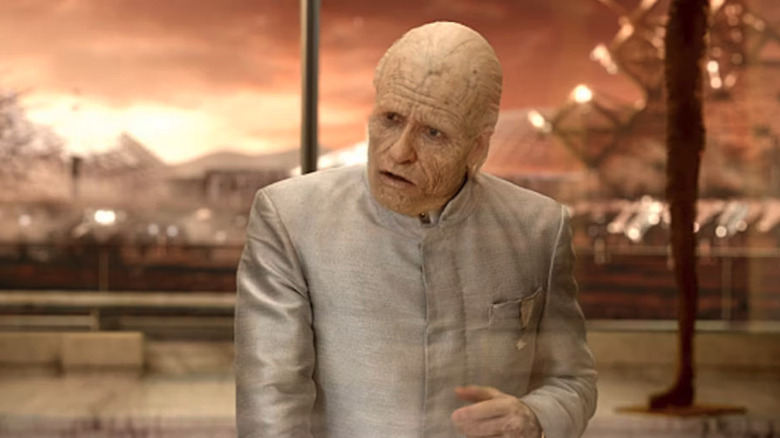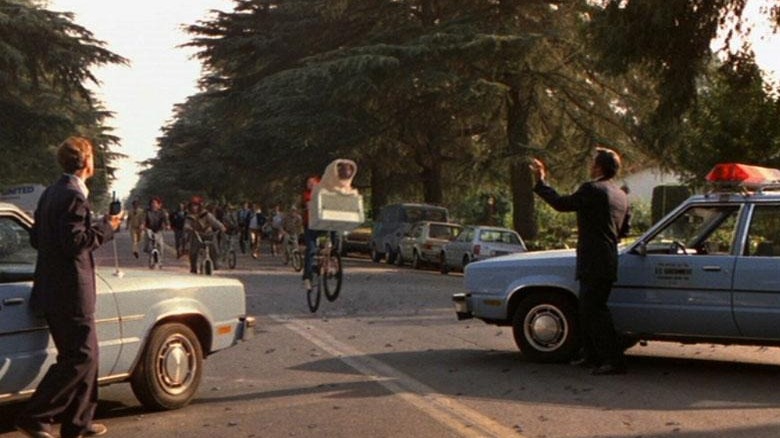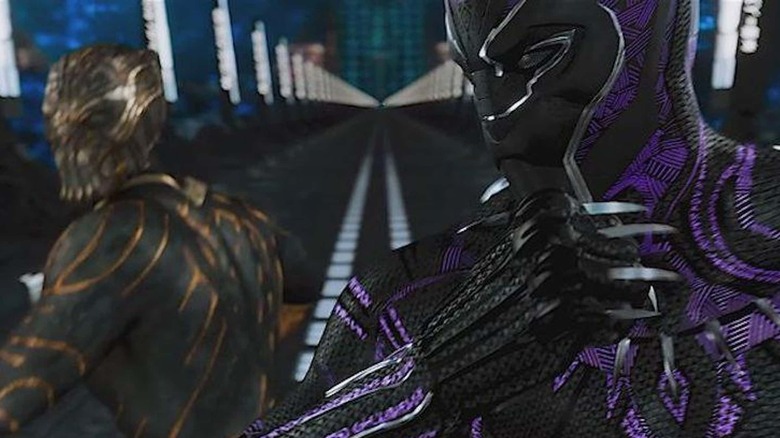Terrible Special Effects In Popular Sci-Fi Movies
Science fiction films have some truly groundbreaking special effects... and really awful and awkward ones, even considering the forgiving eye fans cast on the visual aspect of movies as they age. For every "Metropolis," "2001: A Space Odyssey," "Alien," "or Mad Max: Fury Road," there's a film with a moment (maybe several) when you think "Why?" instead of "How did they do that?"
It isn't a matter of whether practical effects look better in some films than CGI. The effects that don't hold up, even upon their release, tend to call attention to themselves — and not in the best way. As Ann Hornaday, film critic at the Washington Post and author of Talking Pictures put it, "Although great special effects are the result of intensive planning, imagination, and meticulous, time-consuming execution, when they're presented to the audience, they should be nearly invisible."
With all that in mind, here's a look back at some terrible special effects in popular sci-fi movies that took us out of the stories and worlds they were supposed to enrich — as well as some special effects arguably more infamous than their films.
The Matrix Reloaded: The fight of a thousand Smiths
"The Matrix" won four Academy Awards, including one for Best Visual Effects. Even decades later, its signature "bullet time" looks otherworldly as Neo (Keanu Reeves) dodges bullets and blows in a way perfectly befitting the film's artificial reality. The film's first sequel, 2003's "Matrix Reloaded," had a budget of about $150 million and promised effects that were even better — and it includes a freeway chase sequence that certainly clears that bar. On the other hand, a scene of Neo facing off against dozens of clones of his nemesis Agent Smith (Hugo Weaving) in a courtyard is disappointing. Officially dubbed "The Burly Brawl," this set piece took hundreds of takes a day in a 250,000-square-foot hangar, with martial artists performing stunt work that would transform into various Smiths in postproduction. Nevertheless, Reeves, who defies gravity while leaping, spinning, and running, still looks and moves like a human throughout while the Smiths, while at first formidable, dissolve into a blur of suits and ties.
I Am Legend: Into the maw of madness
This 2007 adaptation of Richard Matheson's iconic 1954 novel is the rare film whose fans embrace the first two thirds and tend to give the ending a pass for the most part. As Will Smith's Robert Neville navigates a desolate New York City after a pandemic, the film becomes a poignant and lyrical depiction of loneliness. But whenever Neville crosses paths with one of the infected and mutated humans left behind, the film veers into punched-up action territory, with creatures whose malleable jaws hang low and wide like one of Imhotep's minions in 1999's "The Mummy." Veteran creature designer and production designer Patrick Tatopoulos ("Underworld," "Pitch Black," "Dark City") came up with the overall look, but the creatures' unnatural jaws and physicality becomes jarring during the climax when the Alpha Male (played by Dash Mihok of "Romeo + Juliet," "Punisher: War Zone," TV's "Ray Donovan") hollers and tosses his cohorts about like dolls.
Star Wars: Episode IV – A New Hope: A not-so-special meeting
To mark the 20th anniversary of the "Star Wars" saga in 1997, Lucasfilm released "special editions" of the original trilogy with various changes, such as altering dialogue, replacing matte background paintings with digital versions, adding digital aliens and stormtroopers, and reviving scenes cut from the original. The most infamous is a meeting between Han Solo (Harrison Ford) and Jabba the Hutt, originally portrayed by the late Irish actor Declan Mulholland ("Doctor Who," "Time Bandits") wearing a furry vest.
Apparently, no one minded when he became a gargantuan slug and more menacing adversary in 1983's "Return of the Jedi." However, creator George Lucas's idea to insert the slug-like Jabba over Mulholland's performance was memorable in the worst way. Ford looks fine, maintaining the visual quality of the 1977 film, but the digitally crisp Jabba disconcertingly seems like he slunk in from somewhere else.
Van Helsing: Necks appeal?
After Hugh Jackman made his cinematic mark as Wolverine in 2000's "X-Men" and 2003's "X2: X-Men United," he appeared in this 2004 attempt to feature the monster hunter from Bram Stoker's 1897 Gothic horror novel in his own film series. Anthony Hopkins hammed it up as Van Helsing in 1992's Bram Stoker's "Dracula," which also played up Dracula's sex appeal, so it's no surprise this film gave the count (played by Richard Roxburgh of "Hacksaw Ridge") three comely brides. Characters like Dr. Victor Frankenstein, Frankenstein's Monster, Dr. Jekyll, and Mr. Hyde camp it up along with the vampires until scenes call for the brides to menace possible victims like Kate Beckinsale's Anna Valerious with their exaggerated lantern jaws. Perhaps director Stephen Sommers liked this effect from his "Mummy" films, but it's more Silly Putty than sexy or scary — more like "Mr. Ed laughing," as one writer put it.
The Lawnmower Man: The oversize ghost in the machine
Granted, virtual reality was nowhere near as advanced in 1992 when "The Lawnmower Man" debuted, although it was still ripe for storytelling inspiration (see 1995's "Virtuosity" and 1999's "The Thirteenth Floor," among others). This film, which lifts only its title from a Stephen King story, attempts to tell a cautionary tale about a scientist (a pre-007 Pierce Brosnan) who introduces a developmentally disabled man named Jobe (played by Jeff Fahey of "Lost" and "Alita: Battle Angel") to virtual technology. Unfortunately, whether because of a low budget or a lack of imagination, the virtual world here turns out to be a pretty dull array of geometric mosaics reminiscent of a coloring app. Once Jobe's mind expands and merges with the machine, the digital rendering of Fahey's huge head, complete with eyes that look pasted from a different illustration, flops on the wrong side of the uncanny valley.
Lost in Space: A Blarp in the jungle
Before Netflix reimagined this "Swiss Family Robinson" in space, New Line Cinema launched a 1998 remake of the popular 1965 TV series "Lost in Space" ("Danger, Will Robinson!") with a cast that included Gary Oldman, William Hurt, Mimi Rogers, Heather Graham, Lacey Chabert, and Matt LeBlanc. Set in 2058, the film sends the Robinsons and company to colonize another planet after Earth suffers the effects of global warming. Unfortunately, the actors share screen time, if not physical space, with a CG critter named Blarp, a kind of extraterrestrial monkey. The filmmakers shot Blarp (voiced by veteran foley artist and creature vocalist Gary A. Hecker) with an animatronic puppet that remained in close-up shots, but the special effects department under supervisor Nick Allder ("Alien," "The Fifth Element," and later "Underworld" and "Hellboy") went digital in post-production for everything else. The result leaps out as a creature that's not really there, as the actors obviously aren't interacting with an object in the same scene and have no idea even where to look.
In Time: No time for a stunt
Writer/director Andrew Niccol is responsible for creative and clever films such as 1997's "Gattaca" and 1998's "The Truman Show," and with venerable cinematographer Roger Deakins aboard, 2011's "In Time" held a lot of promise. The plot is a twist on 1970s sci-fi favorite "Logan's Run," set in a future where people don't live past 25 unless they can buy or otherwise finagle more life. But the filmmakers must have run out of time to stage a proper stunt or visual effect once protagonist Will Salas (Justin Timberlake) goes on the run with Sylvia Weis (Amanda Seyfried). How else to explain the unintentionally hilarious sequence in which the couple careens off the road in a convertible? The flipping car looks like a toy — and one that magically lands upright.
Green Lantern: The desolation of smog
Ryan Reynolds jokes in "Deadpool 2" about starring in the flop 2011 superhero origin story "Green Lantern," which we've admittedly singled out before for digitizing the character's distinctive uniform. But the greater distraction -– especially considering the film's reported $200 million budget –- is the depiction of the villain Parallax (voiced by Clancy Brown of "The Shawshank Redemption" and "Thor: Ragnarok"). Parallax is supposed to be the living embodiment of fear, and in the comics, it's more buglike. But the film's roiling black and yellow cloud that spreads over the city in the climactic battle reminds us of that foam sealant that snugs around pipes. It's hard to feel that Hal Jordan (Reynolds) is in danger when he's facing off against an angry cloud. Or bad weather. Even if a toothy skull pops out once in a while. One positive postscript: This film did bring future spouses Reynolds and Blake Lively together.
Independence Day: Splinters and bits
"Independence Day" has the throwback charm of the space invasion films of the 1950s (like "The Thing from Another World" or" It Came from Outer Space") and preposterous energy that makes it tough to dislike. This 1996 film's visual effects team even won an Oscar -– but that doesn't prevent us from giggling at two of its signature moments. As the film's aliens coordinate annihilating various landmarks, they obliterate a five-foot scale model of the White House. It's made of sandstone in real life, but based on the flying splinters, the model was mostly wood. Meanwhile, simultaneously in New York City, the aliens attack the Empire State Building, for which director Roland Emmerich ("The Day After Tomorrow," "2012," "White House Down") ignores geography. Instead of sitting squarely on the corner of a city block where it belongs, the famous skyscraper here appears to rest in the center of the street — the perfect spot for its explosion to flip cars into the air.
Total Recall: An eye-popping finale
1990's Total Recall, a film adaptation of Philip K. Dick's short story "We Can Remember It For You Wholesale," uses practical and CG effects with uneven results. The Academy of Motion Picture Arts and Sciences gave the visual effects team a Special Achievement Award, but it's difficult not to take issue with the woman's mask that Quaid (Arnold Schwarzenegger) removes once it starts to malfunction at a checkpoint, revealing an unconvincing facsimile of the star underneath. There's also unfortunate humor in Quaid, Melina (Rachel Ticotin), and the villain Cohaagen (Ronny Cox) struggling to breathe on the surface of Mars during the film's climax. The actors gamely clutch at their throats and gasp while latex masks of the actors inflate with air pockets to exaggerate their distress. But as their struggle continues, the bulging eyes resemble Tex Avery cartoons. Cox's villain bears the brunt of this, but the changing atmosphere conveniently keeps Quaid and Melina from showing any lasting effects before their final kiss.
Star Trek: The Motion Picture: A lackluster voyage(r)
The original crew of the U.S.S. Enterprise journeyed onto the big screen with this 1979 film whose Oscar-nominated visual effects nevertheless failed to thrill. The climax particularly looks peculiar, as crewman Decker (Stephen Collins) opts to merge with the Voyager spacecraft. The real Voyager missions launched in 1977 and involved twin spacecraft, initially targeting closeup views of Jupiter and Saturn. (NASA says Voyager 1 is still collecting data and crossed the threshold of interstellar space in 2012.) This film imagines Voyager became sentient on its travels through the solar system and adopted the name "V'Ger." The contentious shoot first used special-effects house Robert Abel and Associates, then Douglas Trumbull ("Close Encounters of the Third Kind"), and included a number of injuries as the crew fell through the lights, panels, and plastic surrounding V'Ger when it and Decker meet. The end result is rather meh, with Decker appearing backlit while his hair blows and sparkly lights cascade around him.
Flash Gordon: Ming-a-ring-ring
1980's "Flash Gordon" adapted the classic 1930s comic strips in search of movie magic, and although the end result is spectacularly cheesy, it still inspires a lot of affection, partly because of Queen's soundtrack ("Flash... ah-ah! He'll save every one of us"). The costume and production design from BAFTA nominee Danilo Donati (of "Red Sonja" and "Life Is Beautiful") is also a standout, oozing retro kitsch among all that red and gold. The effects team deserves kudos for inventiveness, creating memorable images like Mongo's multicolored clouds, which fits within the film's aesthetic alongside the lasers and winged Hawkmen. But the demise of the merciless Emperor Ming (the legendary Max von Sydow of "The Seventh Seal" and "Game of Thrones," among many others) fares worse. A wounded Ming holds Flash (Sam Jones) at bay with a pulsing red glow from his ring, saying "Pitiful fool! My life is not for any Earthing to give or take." Then the ring zaps him, dissolving the merciless leader into the jewelry. Out of the picture, but not exactly out of this world.
RoboCop: The Gumby arms
To this day, "RoboCop" remains a seminal classic in '80s sci-fi film, a dystopian story that elevated the genre with its high-tech hero. Full of stinging social satire, the film was also packed with wall-to-wall graphic violence as the cyborg cop blew away the baddies with little mercy. Beyond just plugging ordinary crooks on the streets of Detroit, RoboCop also dealt with corporate and government corruption, with the real villain being Dick Jones, the Senior President of OCP, the company that created him. When Jones finally gets what he deserves, it's literally and metaphorically a big letdown.
Arguably one of the most infamous effects fails in sci-fi movie history, the scene has RoboCop shooting Jones repeatedly, letting loose a barrage of bullets and pushing him out a high-rise window to his death. When the camera cuts to his hundred-story fall to the ground, what the audience gets is an obvious dummy with arms that look comically too long.
While the shot has become a source of mockery for years, a look behind the scenes has since revealed that it might not have been as bad as it seemed. As detailed on Twitter, the dummy for Jones was apparently properly scaled, but the wide-angle camera used to capture the shot may have created the unfortunate distortion of Jones' arms.
Star Trek: Insurrection: The face-off
Between "Star Trek" and "Star Wars," the latter has always had the reputation for the bigger and better special effects. "Star Trek" is famous especially for its often cheap-looking effects on the small screen in the 1960s. It might surprise some to learn that it was actually George Lucas' Industrial Light and Magic that created many of the visual effects for the "Star Trek" feature films, including the early use of CGI in "Star Trek II: The Wrath of Khan." Lucas' ILM was not involved, however, in the making of "Star Trek: Insurrection," the third film for the cast of "The Next Generation," and it shows.
In one climactic sequence, the villain Ru'afo (F. Murray Abraham) subjects the crooked Federation Admiral Dougherty (Anthony Zerbe) to the same procedure that he'd been using to keep his own aging flesh fresh. This time, however, it peels back the skin of the poor Starfleet sucker, and let's just say that the effect isn't up to the standards of a blockbuster sci-fi franchise. Looking more like a haphazard swipe on a Photoshop smudge tool, the effect appears like a last-minute rush job by the VFX team as they ran out of time and money, making an already slapdash sequel look even worse.
Superman: A not-so-super miniature
"Superman: The Movie" is often credited for kicking off the superhero movie boom, as it was the first truly big-budget adaptation of a comic book superhero to capture the moviegoing audience's imagination. A large part of that was its stunning visual effects, which, while not exactly revolutionary, did just enough to make The Last Son of Krypton believable as a dramatic character instead of a children's cartoon. While the film boasts some impressive flying effects and some nice action sequences that look good up on the big screen — especially for 1978 — there's one big moment that doesn't pass muster.
It happens when Lex Luthor (Gene Hackman) fires a series of missiles to destroy key landmarks, including the Golden Gate Bridge and Hackensack, New Jersey (that's right, the iconic American landmark of Hackensack). The missile that hits the San Andreas Fault also destroys the Hoover Dam, and the resulting destruction is captured with the use of a bad miniature that just doesn't work on screen. It's a bad effect that has to be seen in motion to truly grasp what a poor visual moment it really is, but between the tiny town below, the obvious model trains, and the stream of water that's clearly not much more than a bucket's worth, it's not convincing in the least.
Ultraviolet: Ultra-bad CGI
It might not be Milla Jovovich's most famous or best sci-fi classic (that honor goes to the Bruce Willis-starring, Luc Besson-directed "The Fifth Element"), but "Ultraviolet" has become a cult favorite over the years. Popular among its fans for its gloriously over-the-top and downright ridiculous cyberpunk action, the film stars Jovovich as Violet Song, a superhero in a dystopian future who embarks on a mission to protect a boy whose blood may hold the key to curing a disease that has ravaged the planet.
Ultra-violent and ultra-colorful, the effects throughout the movie are substandard at best, but one notorious sequence is head and shoulders above the rest when it comes to its awfulness. It begins with Violet leaping off a building, instantly cutting down a group of gun-toting mercs, and then proceeding to race through the city on her motorcycle. The problem is, large parts of the sequence appear composited using sloppy blue screen effects, while intercut with CGI so embarrassingly bad that it appears downright incomplete. Awkward direction doesn't help, and the result is laughable even by the standards of a Saturday morning cartoon. The scene will have you scratching your head wondering how it made it into a theatrically released motion picture.
Escape From L.A.: Surf's up
Possibly one of the most disappointing sequels to a sci-fi favorite, "Escape From L.A.," which reunited "Escape from New York" star Kurt Russell with original director John Carpenter, has become a genre classic for all the wrong reasons. Fans were probably expecting another iconic action movie, so it couldn't have been pleasant when what they saw was an incoherent mess. Released in 1996, more than a decade after the original, it lacked the originality and freshness of its predecessor, and while the first movie's special effects were never anything groundbreaking, the sequel's are downright goofy.
Case in point is one now-legendary "tsunami surfing" scene, when Russell's Snake Plissken befriends a Malibu surfer (played by Hollywood legend Peter Fonda) and the pair ride a giant water wave through the canyons of post-apocalyptic Los Angeles. From the moment the water comes into view, the VFX are an unmitigated travesty, with bad chroma keying as the flood overtakes a dune buggy and cringe-inducing blue screen usage that never convinces you that the duo are surfing, rather than just awkwardly swaying while standing still.
As they ride the wave, the movie's villain (Steve Buscemi) spots them and says "You gotta be kidding me," echoing the thoughts of everyone watching.
Star Wars: Rogue One: C(r)ushing it
A franchise known for pushing the boundaries of visual effects doesn't always get it right. There are more than minor slip-ups in the re-released Special Editions. In 2016, the newly relaunched franchise came roaring into theaters with its first-ever standalone film, "Rogue One: A Star Wars Story," which explored the untold story behind how the Rebel Alliance stole the plans to the Death Star. In addition to introducing a host of new and exciting heroes and villains, though, it also brought back a few old faces, including Grand Moff Tarkin, a key villain from the original "Star Wars" film in 1977.
The problem, of course, is that the actor who played him — Peter Cushing — had died in 1994. Rather than simply cast a new actor to play him, the VFX wizards at Industrial Light & Magic tried to resurrect him through CGI. Using motion capture performed by actor and Cushing impersonator Guy Henry augmented with state-of-the-art effects, they brought Tarkin back to life, but it wasn't quite convincing for many. Looking acceptable in shadow, and sometimes adequate when motionless, the CGI-created Tarkin falls deeper into the uncanny valley the longer he's on screen, with some moments making him almost feel like a character on the animated "Clone Wars" TV series.
TRON: Legacy: An uncanny smoothening
Before Hollywood was attempting to create CGI people from scratch, it used the technology for de-aging. After a few awkward attempts in a couple of "X-Men" movies, Disney tried it in the legacy sequel to the 1982 cult classic "Tron." Directed by Joseph Kosinski and released in 2010, "TRON: Legacy" saw original star Jeff Bridges return as Kevin Flynn, a computer programmer trapped in a digital world. He's ultimately rescued by his now-adult son Sam (Garrett Hedlund), and in both flashbacks and inside the digital world, de-aging is used to make the 61-year-old Bridges look decades younger.
Unfortunately, the results aren't quite as convincing as one might hope. The younger Bridges — both as a 30-something Flynn and as his digital double Clu — looks like something out of a video game cutscene. Granted, digital de-aging still hadn't been perfected. It's since been used to better effect in later movies like "Gemini Man" and "The Irishman." It seems "TRON: Legacy's" reach exceeded its grasp, trying to make real what technology wasn't quite ready for. It's made all the worse because outside of the de-aging, the VFX in "TRON: Legacy" are truly astounding.
Cloud Atlas: Just plain offensive
The centuries-spanning sci-fi saga "Cloud Atlas" was an ambitious project from the Wachowskis, the makers of "The Matrix." It featured an all-star cast of actors playing multiple roles across time and space. Tom Hanks, Halle Berry, Susan Sarandon, and Hugh Grant all played characters reincarnated across five centuries into new roles, often swapping races.
If you think that sounds insensitive and even a little bit troubling, you'd be right, because the movie quickly found itself at the center of controversy for turning several white actors into Asian characters in what is commonly referred to as "yellowface." To make matters worse, the make-up effects used to achieve it were mind-bogglingly awful. "In the modern age of movie make up, it is disturbing to see poorly done Asian eye prosthetics to make Caucasian men look Asian," said Guy Aoki, a spokesperson for the Media Action Network for Asian Americans, in a statement published in The Hollywood Reporter.
More than just terrible effects, it was offensive and harmful to Asian stereotypes, and a missed opportunity for Hollywood to find more roles for Asian actors. "It would have been a great, stereotype-busting role for an Asian American actor to play, as Asian-American men aren't allowed to be dynamic or heroic very often," Aoki added, referring to the character played by white British actor Jim Broadbent.
Aliens: Whack-a-droid
A bad effect in the 1986 classic "Aliens?" Say it ain't so! Well, we're going to say just that, with a few caveats. Admittedly, there aren't many faults to be had with James Cameron's iconic sequel, which turned the previous film's creepy horror story into a fast-paced, run-and-gun space action movie that still hasn't been topped. The film begins with Ellen Ripley (Sigourney Weaver) being awakened from cryo-sleep decades after the first movie and sent with a team of space marines to investigate the alien Xenomorphs.
As for the effects, almost all of them are as good as anything seen in cinema at the time and contribute to the film's incredible impact. Yet there's one moment that loses us in the final act. It comes when the android Bishop (Lance Henriksen) is torn in half by the alien queen. While it certainly looks at first glance like a convincing effect, it quickly becomes clear that the actor is simply hidden in the floor, while sloppy goop and oatmeal are poured all over him.
At the same time, because he's unable to move, lest he give away the visual trick, Henriksen's mere immobility breaks the illusion. As many eagle-eyed fans have since noticed, when he does have to move, swinging around to catch the falling Newt, the hole in the set where Henriksen is standing becomes clearly visible, ruining the movie magic even if you'd bought it to that point.
The Terminator: I spy with my little red eye
Director James Cameron is famous for his first-rate special effects, and here we are accusing two of his films of having terrible special effects? It might sound hard to believe, but we're making a case that there's at least one moment in the groundbreaking classic "The Terminator" that qualifies it for a spot on this list. No, it's not any of Stan Winston's brilliant work on the T-800 endoskeleton, expertly brought to life in a final battle with Sarah Connor at the end of the film. Instead, it comes in a disturbing sequence when the Terminator is forced to self-repair the damage to his eye.
First, we want to preface our criticism with the fact that the effect of the Terminator cutting out his own eyeball is definitely a moment that effectively makes audiences squirm with discomfort. But the after-effect, when the Terminator stands back and looks at himself in the mirror, just doesn't hold up to basic scrutiny. While it was state-of-the-art puppet work for its time, it doesn't look real and is almost unrecognizable as a doppelgänger of Arnold Schwarzenegger.
Proof that "less is more," the scene is at its most gruesome when the self-surgery takes place off-camera, in shadow, or in close-up. The full reveal of the latex and rubber dummy head with an obvious wig, meanwhile, nearly threatens to ruin the entire sequence.
Hitchhiker's Guide to the Galaxy: The Pez Dispenser
"The Hitchhiker's Guide to the Galaxy" was once a BBC television series in the early 1980s, but in 2005 it made its way to the big screen after spending years stuck in development hell. The film starred Martin Freeman, star of the UK sitcom "The Office," as Arthur Dent, an ordinary man swept up in an interstellar adventure alongside Earth girl Trillian (Zooey Deschanel) and alien guide Ford Prefect (Mos Def), who take him aboard a starship to meet the President of the Galaxy, the two-headed Zaphod Beeblebrox (Sam Rockwell).
Though the film boasts some truly creative visuals and incredible practical alien effects, the CGI used to bring Zaphod's double noggins to life is sorely lacking. They aren't bad per se, just terribly ill-conceived. Likely in an effort to avoid the effects necessary to give Zaphod two heads at all times, his second face is hidden beneath his collar under his chin. Though it only pops up a few times, the effect is awkward. Fans have come to affectionately refer to it as the "Pez Dispenser" head, and while the CGI isn't entirely awful, it's not really that convincing either. That said, it still beats a fake rubber head on a stick, which is how they did it on television back in the 1980s.
Prometheus: The wrinkled potato
Digital de-aging in sci-fi can backfire badly, but bad old-age make-up can too. The most astonishing might be in Ridley Scott's "Prometheus," the long-awaited prequel to the 1979 classic "Alien," which took a look at the origins of the Xenomorphs and introduced the founder of the infamous Weyland-Yutani Corporation. In the film, Peter Weyland is portrayed as an elderly old man on a life-long quest for the answers to the meaning of humanity's existence. For some reason, director Ridley Scott cast the then-44-year-old actor Guy Pearce to play the 104-year-old.
Old-age effects had already been done successfully for decades, pulled off brilliantly with make-up in movies like "Citizen Kane" and "The Godfather" and via CGI in "The Curious Case of Benjamin Button." For some reason, the prosthetics and make-up effects used on Pearce never seem to work, looking like some kind of weird alien cartoon character. Rubbing salt in the wound, the only reason Pearce was even cast was that early versions of the story had included flashbacks to Weyland as a younger man that were ultimately excised from the film.
Oddly enough, Scott's original choice for the role was Max Von Sydow, who had similarly been aged up for "The Exorcist," with a much more convincing make-up effect.
E.T.: The Extra-Terrestrial: An awkward retro-fitting
George Lucas wasn't the only director to use advanced computer-generated special effects to overhaul one of their older classic masterpieces. In the wake of the "Star Wars" special edition rereleases, Steven Spielberg decided to give his 1982 sci-fi family film "E.T.: The Extra-Terrestrial" a digital facelift in honor of its 20th anniversary. This included using CGI to spruce up existing practical effects, finish incomplete deleted scenes for newly included moments, and even to re-do old scenes that he was no longer fond of.
Arguably the most famous change made is the erasure of all guns from a final scene where the police try to apprehend little Elliott and E.T., replacing them with CGI walkie-talkies. Though it was fine in 1982, by 2002 Spielberg felt that having guns in a kids' movie wasn't entirely appropriate. The replacement is awkwardly executed to the point of looking silly, making the movie lesser for it in addition to being an unnecessary change.
That's certainly not all, as a deleted scene that sees E.T. taking a bath is finished with CGI that looks woefully out of place in a movie notable for its quality practical alien effects. In 2023, though, the director admitted that the CGI "additions" were a mistake.
Black Panther: The catfight
To make a great modern superhero action blockbuster, first-class visual effects are crucial. Some of the best comic book films have done it right, with a number of Marvel movies being nominated for best visual effects at the Academy Awards. One MCU entry, though, that didn't receive a nomination for its effects was 2018's "Black Panther," which had some questionable moments that drew plenty of criticism, particularly in its final battle.
One moment that stands out to fans is the climactic showdown between T'Challa (Chadwick Boseman) and his rival Erik Killmonger (Michael B. Jordan). Both are clad entirely in CGI-created, cat-inspired superhero suits and face off in an entirely CGI environment. The effect is — to put it delicately — unremarkable. Engadget went in-depth on the bad CGI modeling used in the film, calling it "weightless, ugly, and, worst of all, incredibly distracting." The author wondered how a blockbuster film in 2018 could have effects this bad, while "War for the Planet of the Apes," released a year earlier, was so impressive.
